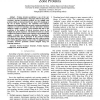133 search results - page 6 / 27 » Prediction of protease substrates using sequence and structu... |
JMLR
2010
13 years 2 months ago
2010
Structured prediction tasks pose a fundamental trade-off between the need for model complexity to increase predictive power and the limited computational resources for inference i...
BIOINFORMATICS
2010
13 years 7 months ago
2010
Motivation: Existing methods for protein sequence analysis are generally firstorder and inherently assume that each position is independent. We develop a general framework for int...
BMCBI
2008
13 years 7 months ago
2008
Background: Accurate identification of splice sites in DNA sequences plays a key role in the prediction of gene structure in eukaryotes. Already many computational methods have be...
BMCBI
2007
13 years 7 months ago
2007
Background: Predicting protein residue-residue contacts is an important 2D prediction task. It is useful for ab initio structure prediction and understanding protein folding. In s...
CIBCB
2006
IEEE
14 years 1 months ago
2006
IEEE
– Protein structure prediction is one of the core research areas in bioinformatics. This paper addresses the protein secondary structure prediction problem for the twilight zone ...

